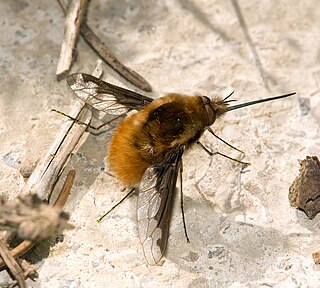
The Bombyliidae are a family of flies, commonly known as bee flies. Some are colloquially known as bomber flies. Adults generally feed on nectar and pollen, some being important pollinators. Larvae are mostly parasitoids of other insects.

Toxophora is a genus of flies belonging to the family Bombyliidae (bee-flies). There are about 47 described species, distributed throughout the world, although they are most abundant in Southwestern United States and western Mediterranean. They are stout, robust flies with a hunchbacked form, with a body length of 6–12 mm and wings 4 to 7.5mm. Most species are black with banding or spots.

Toxophorinae is a subfamily of bee flies in the family Bombyliidae. There are five living genera and two extinct genera containing more than 400 described species in Toxophorinae.

Systoechus is a genus of bee flies in the family Bombyliidae. There are more than 120 described species in Systoechus.
Tmemophlebia coquilletti is a species of bee fly in the family Bombyliidae.
Toxophora virgata is a species of bee fly in the family Bombyliidae. It is found from Mexico through most of the western United States north to Canada. Hosts include potter wasps from the genera Odynerus and Stenodynerus.
Lordotus zona is a species of bee fly in the family Bombyliidae.
Chrysanthrax lepidotoides is a species of bee fly in the family Bombyliidae. It is known only from New Jersey.
Toxophora pellucida is a species of bee fly in the family Bombyliidae. It is found from Mexico through most of the western United States north to Canada.
Thyridanthrax andrewsi is a species of bee fly in the family Bombyliidae. It is found in the United States in California and Idaho.
Lordotus planus is a species of bee fly in the family Bombyliidae.
Toxophora leucopyga is a species of bee fly in the family Bombyliidae. It is found in the southwestern United States from Louisiana to North Carolina

Thyridanthrax fenestratoides is a species of bee fly in the family Bombyliidae. It is found in Canada from the Yukon to Ontario, south through most of the United States, and into Mexico. It is similar to the species T. fenestratus from Eurasia.
Lordotus divisus is a species of bee fly in the family Bombyliidae.
Lordotus gibbus is a species of bee fly in the family Bombyliidae.
Lordotus striatus is a species of bee fly in the family Bombyliidae.
Conophorus fallax is a species of bee fly in the family Bombyliidae. It is found in North America, from the Yukon to Saskatchewan in Canada south to New Mexico and California in the United States.
Conophorus atratulus is a species of bee fly in the family Bombyliidae.

Toxophora amphitea is a species of bee fly in the family Bombyliidae. It is found in eastern North America from Ontario south to Florida and Texas.
Conophorus collini is a species of bee fly in the family Bombyliidae.




